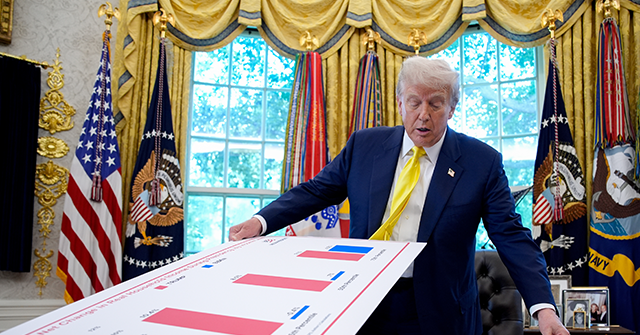The Optimal Tariff Is Much Higher Than We Thought
In a working paper circulated this spring, economists Oleg Itskhoki of UCLA and Dmitry Mukhin of the University of Wisconsin-Madison revisit one of the most controversial questions in international economics: when, if ever, should a country impose tariffs? Their answer, framed in elegant mathematical terms and grounded in the financial realities of today’s global economy, is both surprising and—perhaps unintentionally—vindicating of the Trump administration’s trade agenda.
Their central claim is straightforward. Even in a financially sophisticated and deeply globalized world, there is still an optimal tariff for a country like the United States. Once global capital flows, currency movements, and the structure of external assets are taken into account, the textbook logic favoring free trade weakens and in some cases, reverses.
The numbers are eye-catching. In a stylized benchmark with balanced trade, they find a welfare-maximizing U.S. tariff of 34 percent, with a revenue-maximizing rate approaching 80 percent. When calibrated to reflect actual U.S. economic conditions—persistent trade deficits and a large stock of dollar-denominated foreign liabilities—the “optimal” rate falls to around nine percent. Still positive. Still economically justifiable. But importantly, smaller than pure goods-market logic would suggest.
That shift comes down to what the authors call “valuation effects”: the fact that imposing a tariff strengthens the dollar, which in turn reduces the dollar value of U.S. foreign assets. In other words, part of the gain in trade terms is offset by a hit to America’s international investment position.
No Retaliation, No Problems
But the real-world implications of the paper may go further than its authors explicitly argue. While the theoretical framework assumes symmetric retaliation—a so-called Nash equilibrium of mutual tariffs—recent history offers a different pattern. Over the past six years, the United States has imposed sweeping tariffs on dozens of countries, including China, the European Union, and Japan. But instead of a cycle of tit-for-tat escalation, the response has often been negotiation and accommodation.
Japan signed a bilateral deal. The EU resumed trade talks. Even China, after a prolonged standoff, agreed to large-scale purchase commitments. India, targeted earlier this month with a new round of tariffs due to its imports of discounted Russian oil, has thus far responded diplomatically. The worst-case scenario envisioned in many economic models—a full-scale tariff war—has yet to materialize.
That reality changes the math.
As Itskhoki and Mukhin emphasize, the costliest outcomes in their model come from retaliation. But if partners choose instead to accept tariffs and offer concessions—cutting their own barriers, pledging investment, or agreeing to quantity-based trade deals—the welfare gains from U.S. tariffs become significantly larger. The authors do not model these kinds of side payments, but they would act as additional terms-of-trade improvements, directly increasing U.S. income while reducing the necessary tariff rate to achieve trade-balance goals.
Put simply, when tariffs serve as a negotiating lever rather than a permanent regime, and when they succeed in eliciting economically valuable concessions, the underlying logic of the paper tilts further toward support.
There is also a political and legal nuance the paper nods to obliquely. In theory, production and export subsidies are the most efficient way to raise employment in tradable sectors—especially manufacturing. In practice, however, such subsidies are often difficult to implement, politically controversial, or prohibited by trade agreements. Tariffs, by contrast, are straightforward, enforceable, and legally authorized under U.S. trade law. Managed-trade agreements with investment and purchase pledges effectively mimic the model’s subsidy channel—just delivered through diplomatic means rather than fiscal transfers.
Modern Trade Theory Supports Tariffs
What makes Itskhoki and Mukhin’s contribution so significant is not just its conclusions, but its modern framing. Rather than viewing tariffs as a throwback to a pre-global era, they present them as a macro-financial instrument, with predictable effects on the trade balance, the exchange rate, and the international investment position. Their work offers a rigorous counterpoint to the dominant narrative that tariffs are inherently disruptive or self-defeating.
To be clear, the paper is cautious. The authors acknowledge that their calibration is approximate, that sectoral frictions and long-run dynamics remain outside their scope, and that their results are sensitive to assumptions about asset composition and currency denomination. But the broader message is unmistakable: the debate over tariffs deserves a more nuanced, updated economic treatment.
With Donald Trump now back in the White House and tariffs once again at the center of U.S. trade policy, Itskhoki and Mukhin’s paper may stand as the most rigorous academic defense yet of the administration’s approach. The tariffs are already in place. Retaliation, for the most part, never arrived. What followed instead were trade agreements, investment pledges, and targeted purchase commitments—exactly the kinds of negotiated concessions that amplify the model’s predicted gains. Viewed through their framework, Trump’s tariff policy wasn’t a departure from sound economics. It was the real-world application of a theory the profession is only now beginning to formalize.
Read the full article here
